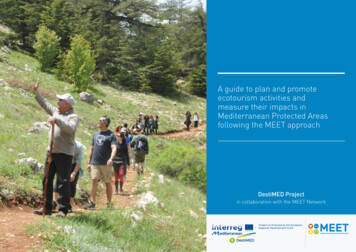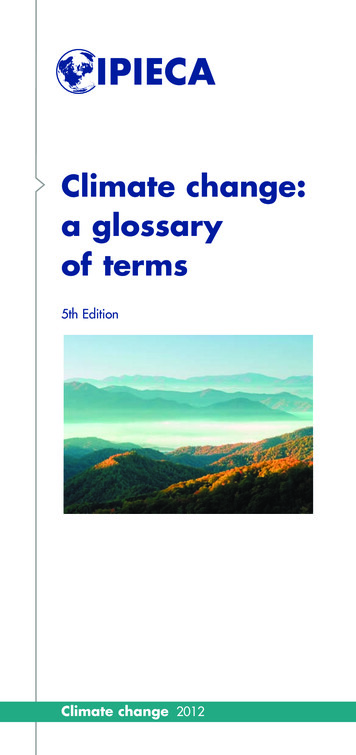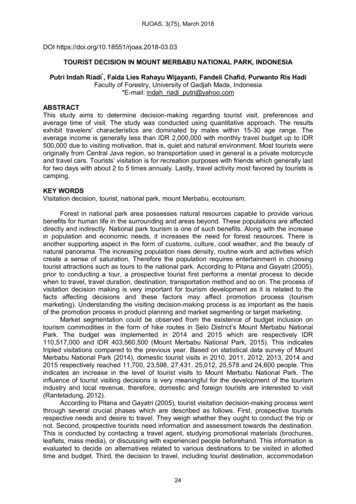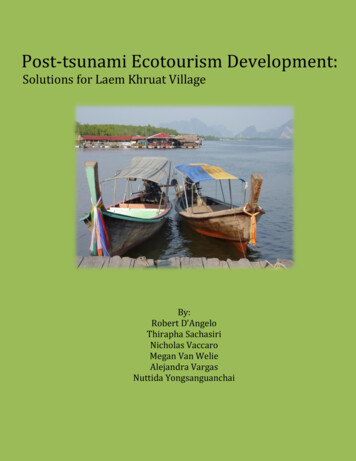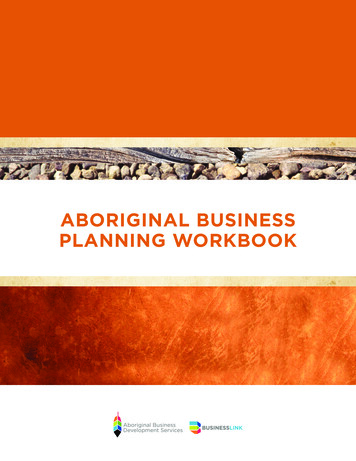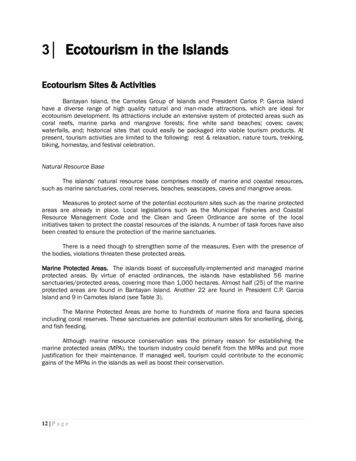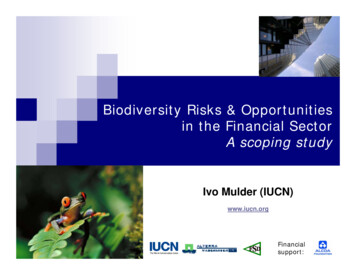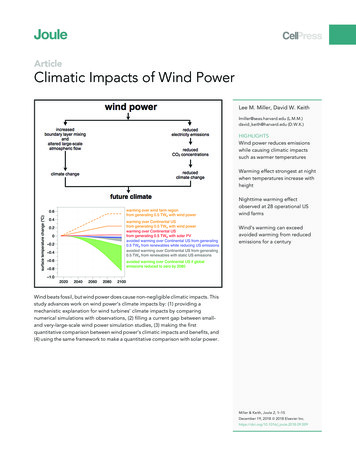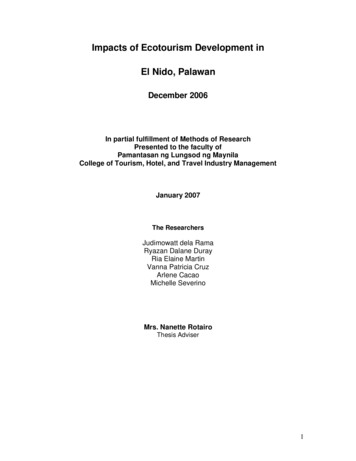
Transcription
Impacts of Ecotourism Development inEl Nido, PalawanDecember 2006In partial fulfillment of Methods of ResearchPresented to the faculty ofPamantasan ng Lungsod ng MaynilaCollege of Tourism, Hotel, and Travel Industry ManagementJanuary 2007The ResearchersJudimowatt dela RamaRyazan Dalane DurayRia Elaine MartinVanna Patricia CruzArlene CacaoMichelle SeverinoMrs. Nanette RotairoThesis Adviser1
Table of ContentsPageAbstract1Chapter IIntroductionStatement of the ProblemObjective of the StudyHypothesisSignificance of the StudyScope and DelimitationConceptual FrameworksTourism conceptual frameworkDefinition of Terms466789101112Chapter IIReview on Related LiteratureTourismEcotourismProtected AreasEl Nido ProfileGovernment OrganizationNon-Government Organization16162132395556Review on Related StudiesForeign studiesLocal StudiesChapter IIIMethodologyCollection of DataInstruments of Collecting DataInterviewSurveySample and Sampling TechniqueObservationStatistical Treatment of DataTime Table59647777787879808182832
Chapter IVResults and DiscussionSurvey resultsDiscussion of Ecotourism Development cPrimary data key informants8484102102105105106110111Chapter VConclusions and Recommendationssummary of sSample questionnaireCurriculum vitaePICTURESPicture 1: Map shows the immediate area of El Nido town and Bacuit Bay in NorthernPalawanPicture 2: Map of El Nido townTABLESTable 1: Locals choice for El Nido's DevelopmentTable 2: Tourist choice for El Nido's DevelopmentTable 3: Locals’ Level of Awareness of the Need for Conservation of El NidoTable 4: Awareness of the Locals in projects and programs of LGUTable 5: Involvement of Locals in the programs of LGUTable 6: Locals that are benefited from Ecotourism development3
Table 7: Locals affected by the Conservation Laws and Programs in El NidoTable 8: Willingness of Locals to leave their traditional way of living for tourismdevelopmentTable 9: Frequency of Visit of Tourist in El NidoTable 10: Tourist Awareness that El Nido is a Protected AreaTable 11: Tourist willingness to pay for Conservation FeeTable 12: Willingness of Tourist to Pay for ConservationTable 13: Tourist Collecting Natural SouvenirsTable 14: El Nido's need for Infrastructure as perceive by the TouristTable 15: El Nido's need for Superstructure development as perceive by the TouristFIGURESFigure 1: Percentage of Locals choice for El Nido’s DevelopmentFigure 2: Percentage of Tourists choice for El Nido's DevelopmentFigure 3: Percentage of Locals Awareness of the need for Conservation in El NidoFigure 4: Percentage of the locals’ awareness in projects and programs of LGUFigure 5: Percentage of Involvement of Locals in the programs of LGUFigure 6: Percentage of Locals that are benefited from the Ecotourism DevelopmentFigure 7:Percentage of Locals affected by the Conservation Laws and Programs in ElNIdoFigure 8: Percentage of Locals to leave their traditional way of living for TourismdevelopmentFigure 9: Percentage of Frequency of Tourist's Visit in El NidoFigure 10: Percentage of Tourist Purpose of Visit in El NidoFigure 11: Percentage of Tourist's Awareness that El Nido is a Protected AreaFigure 12: Percentage of Tourist willingness to pay for Conservation FeeFigure 13: Percentage of Amount of the Tourist willing to pay for Conservation FeeFigure 14: Percentage Of Tourist ActivitiesFigure 15: Percentage of Tourist Collecting Natural SouvenirsFigure 16: Percentage of the need for Development in Infrastructure perceived by thetourist.Figure 17: Percentage of need of development in El Nido in Superstructure as percieveby the Tourist4
5
AbstractThe impact of tourism in a protected area has been the subject of recent concern.According to the Department of Tourism (DOT) and Department of Environment and NaturalResources (DENR) 2002, tourism in the Philippines contributes about 9 percent of the GrossDomestic Product (GDP) and generates about 5 million jobs.Therefore, to be able to make the industry sustainable, developments are to be madeand are to be monitored. The researchers then target to assess the impact of ecotourismdevelopment in the town of El Nido, Palawan. One of the objectives of this research is to knowthe negative and positive factors of development, and proposes measures that would eventuallyreduce the negative impacts. Different methods and designs were used in collection of data.Interviews and surveys were conducted in order to get the appropriate data that the researchersneed for the accomplishment of the study.Knowing the impacts of development of ecotourism in El Nido is indeed very significantnot only for the researchers but also for the Government agencies such as the Department ofTourism, Department of Environment and Natural Resources and the local governmentconcerned. It is also important for the educational institution and for the future researchers.The Scope of the study is mainly the different aspect of Ecotourism and the relationshipsof each component. The respondents of the study are primarily the locals and the tourists of ElNido. The seven-month period of the study was conducted from June 2006 up to January 2007.The descriptive method was used to utilize the thesis and various methods of gatheringinformation were chiefly normative survey technique to gather data from the locals and tourists ofEl Nido that serve as the vital information for the study. Interview was conducted to the keyinformants involved for the conservation and facilitation of El Nido. Observation was also used toevaluate and experience the ecotourism itself in El Nido.For gathering secondary data, the library and internet research was used to source outinformation and data from different clippings, and other supporting documents.The statement of the problem in the thesis: “What are the impacts of ecotourism modernization inthe town of El Nido, Palawan?”Out of 50 local respondents for the, 100% are aware that El Nido is a protected area.Seventy two percent of the local respondents are pro conservation, 18% are pro developmentand 10% answered both.6
Out of 50 respondents of the tourists, 68% of them are aware that El Nido is a protectedarea while 32 % are not aware of it. As for their stand whether they are pro development or proconservation, 68% are pro conservation and 32% are pro development.The four factors that were affected by the ecotourism development are the technical,social, environmental, and economic factors were also discussed in the thesis. On the otherhand, the laws, policies and rules and regulations is considered as one of the causes of theconservation and guide for development of El Nido town. Each aspect has a pro and cons inrespect to ecotourism perspective wherein the combination of these aspects depicts the holisticimpact of ecotourism in El Nido.Technical factor discusses the infrastructure and superstructure within El Nido and how itcontributes to the ecotourism of the municipality. Social factor is concerning about the culture andthe way of living of the people of El Nido. Environmental factor discusses about the effects ofecotourism development in biodiversity (marine and terrestrial) of El Nido.Economic factordiscusses about the distribution of all the supply in parallel to the demands of the people in ElNido. The laws, policies and rules and regulation part is the presentation of different laws, rulesand regulations governing environmental preservation of El Nido.This approach drew the attention to the importance of ecotourism as well as maintainingthe natural resources through proper conservation management and proper tourism developmentto achieve sustainable improvement.7
CHAPTER IIntroductionThe Philippines is a tropical country and home to many life forms that can survive itstropical climate. Among the 7,107 islands in the archipelago, Palawan is blessed with the richestnatural biodiversity, making it the sanctuary of natural biodiversity in the Philippines.Picture 2 Map shows the immediate area of El Nido town and Bacuit Bay in Northern Palawan.In the Northern part of PalawanIsland is located a municipality named ELNIDO.Thismagnificentplacehidescaptivating sceneries that will give you aglimpse of paradise. El Nido has six kindsof ecosystem. One of these are forests,home to six species of large terrestrialmammals endemic to the Palawan faunal region. It has 16 species of birds endemic to Palawan,ten of which are considered threatened. Due to the topographical location of El Nido, it isconsidered as a sanctuary to myriads of marine species and most of them are endemic to theregion. This place has a rich biodiversity, from its beautiful shores up to the range of its virginforests. El Nido’s rich flora and fauna attract local and foreign tourists, paving the way todeveloping the area into a major ecological tourist spot. Government and private institutions areworking hand-in-hand with one goal — to preserve the Philippines’ last ecological frontier.The main sources of livelihood in El Nido are fishing, commercial logging, and agriculture.This source of livelihood serves as a gateway to human exploitation of natural resources.Another means of livelihood is the Tourism sector, because of constant exposure and itsgrowing popularity, however, foreign, as well as local developers saw El Nido as a potentialtourist hub. Different tourism establishments, infrastructures and superstructures were built forthe convenience of tourists. Soon, El Nido’s tourism flourished and became a thriving economicsector in Palawan.8
Statement of the problem:This research is made to answer the following question: What are the impacts of ecotourism development in the town of El Nido?From this question, the researchers came up with the following sub questions: What are the positive and negative effects of ecotourism modernization in thetown of El Nido? How will ecotourism modernization affect the town and its inhabitants? How will El Nido, Palawan maintain its pristine ecological condition while strivingfor modernization? How did the Ecotourism in El Nido affect the economic lifestyle of the place?Objective of the Study: To know more about the present condition of one of the Philippine’s World classEcotourism destination, El Nido, Palawan. To identify the positive and negative part of ecotourism development in El Nido town. To determine the issues concerning El Nido’s protected areas with respect to ecotourismmodernization To find out plans and strategies for preserving El Nido’s rich natural resources and at thesame time developing ecotourism.HypothesisBased on the statement of the problem of this research, “What are the impacts ofEcotourism Development in the Town of El Nido?”, the researchers made assumptions on bothpositive and negative impacts of ecotourism development. These assumptions are as follows: Economic improvement in the town. Generation of local jobs. El Nido will be known to the world as an ecotourism spot which will attracts moretourists, especially those who are nature-lovers, thus, protecting the environmentand promoting conservation to make it sustainable. Degradation of natural resources and negative impact on the environment mightoccur.9
Population growth Over exploitation of biodiversity. Poor Waste management / disposalSignificance of the StudyThe study will be of help to the following agencies and entities: The Researchers – to be able to apply what they have learned, as well as recognize thevalue of ecotourism and biodiversity in the country’s tourism industry. Department of Tourism - for future planning, budget allocation, and development of the“protected areas” such as El Nido, Palawan; and for promotion of ecotourism spot Philippine Tourism Authority – for the development and monitoring of priority areas such asEl Nido, Palawan, as well as for promoting tourism areas to generate revenues to fundnational and corporate development; Local Government Unit of Municipality of El Nido- for them to know the current impact ofecotourism to serve as one of their basis in evaluating the town’s development. Non-Governmental Organizations- this study will help them to come up wider view foranalyzing the impacts of ecotourism in line with their primary concern, which is theenvironment. Tourism Education – for its contribution to the improvement of travel research methods.Institutions of higher learning, particularly universities with departments of hotel andrestaurant management, hospitality management, and tourism, have a vital need for suchinformation. Some educational organizations are concerned with the teaching of tourismand related subjects, and need the most current available research findings to help them ineffectively teaching the subject; Future Researchers – to serve as a source for secondary data for their thesis.Scope and DelimitationThis study was conducted and focused on the town of El Nido, Palawan specifically inBarangay Maligaya, Buena Suerte, and Masagana. The researchers’ study was limited to theeffects of ecotourism development in the town of El Nido. The researchers limited the study on10
the four aspects that are to be considered in ecotourism (e.g. technical, social, environmental,and economic).The technical aspect of the study was focused in El Nido’s infrastructure andsuperstructure in related to their tourism activities. The social aspect of the study was mainlyconcerned in El Nido’s cultural heritage and the effect of ecotourism on the town’s populace,since their task is to keep the area preserved. The environmental aspect is limited to the differentissues concerning the environmental condition of the El Nido town. The study did not delve intothe topic of biodiversity with respect to the different species found in the area, as it is beyond thescope and purpose of this study. To understand more about the environmental concerns, thestudy goes in depth to analyze governmental laws and policies that administer El Nido as aProtected Area. The last factor that the researchers considered was the economic aspect of ElNido town restricted to the description of supply, demand and price. The researchers observedand immersed to come up with a reliable input in this study.Interviews and surveys were limited to tourists, the local townsfolk, and organizationsinvolve in ecotourism development and protected area conservation. (e.g., biodiversity)The study was conducted from the month of July 2006 to January 2007.11
Conceptual FrameworkStudy’s Conceptual unicatingwithdifferentpotentialsponsorsPreparation ofAppropriateguidelines andstandards fortourismdevelopmentPromotion ofprograms andstrategiesSupportingseminars ofLGUs inconservationand tainableDevelopment ofEcotourism inEl NidoWell managedtourismpromotion anddevelopmentBiodiversityconservationAs expressed in figure 1, the Input-Process-Output (IPO) of the study depicts the actionsplanned, the process they have to undergo to be able to come up with good outcomes that aim tohave sustainable development not only to the physical development but also for nature’spreservation of El Nido.12
.Tourism conceptual frameworkSource: Mathieson and Wall13
The conceptual framework above (figure 2) shows the flow of tourism. The three elements suchas the dynamic, static, and consequential elements work in a circular movement. The dynamicelement, which includes the demand of tourists, would later create forms of tourism. From thiselement, the static element would follow creating tourist destination, pressure generation, and thecarrying capacity. Characteristics affecting these three are the characteristics of the touristdiscussing the duration of stay, type of tourist activity, level of usage, level of satisfaction, and thesocio economic characteristics. The destination characteristics discussing the environmentalprocesses, economic structure, political organization, level of tourist development and sociostructure and organization.All the Static Elements creates the impact of tourism that is considered to be a part ofconsequential elements of tourism. These impacts of tourism has a direct effect on the economic,physical and social aspect, that eventually must have an impact control in terms of financing,imposing management strategies policy, providing carrying capacity guidelines and givingengineering controls.Thus, after this cycle the demand will start again and the cycle will go all over again.14
Definition of termsBiodiversity - The variability among living organisms on the earth, including the variability withinand between species and ecosystems.Conservation – refers to the wise use of natural resources that assures regeneration andreplenishment for continuous benefitConversational - An informal discussion of a matter by representatives of governments,institutions, or organizations.Core zone - This area shall be designated free from any human activity. This includessanctuaries for rare and endangered species, selected coral reefs, sea grass and mangroveecosystem reserves.Diversity - the presence of a wide range of variation in the qualities or attributes underdiscussion.Ecosystem - a system formed by the interaction of a community of organisms with their physicalenvironment.Ecotourism - Tourism involving travel to areas of natural or ecological interest, typically underthe guidance of a naturalist, for the purpose of observing wildlife and learning about theenvironment.Endemicity - natural to or characteristic of a specific people or place; native; indigenousEnvironment – all aspect of the surroundings of human being cultural, natural, and man-made,whether affecting human beings as individuals or in social group.Globalization - To make global or worldwide in scope or application.Heterogeneous - consisting of elements that are not of the same kind or nature.Holocene - Of or belonging to the geologic time, rock series, or sedimentary deposits of the morerecent of the two epochs of the Quaternary Period, beginning at the end of the last Ice Age about11,000 years ago and characterized by the development of human civilizations.Impact - the striking of one thing against another15
Infrastructure – the facilities, equipment, and installations needed for the basic functioning anddaily lives of the residents of a region. This includes communication systems, water and sewagefacilities, public protection, and health, transportation, and education systems.Development - To accept or adopt modern ways, ideas, or style; development in terms ofphysical, social, environmental and economic aspect.Mortality - The rate of failure or loss.Multiple use zone - Aside from being development area, this zone also serves as the buffer zonewhere fishery, mariculture, recreation, rehabilitation of small islands and mangrove ecosystemeducation and research are allowed.Natural resources -refers to life-support systems such as the sea, coral reefs, soil, lakes,rivers, and forest as well as useful products found therein such as animals, wildlife, tress andother plants, including the aesthetic attributes of scenic sites that are not manmade.Preserved - An area maintained for the protection of wildlife or natural resources.Protected Area - as defined by the World Conservation Union (IUCN) an area of land and/or seaespecially dedicated to the protection and maintenance of biological diversity, and of natural andassociated cultural resources, and managed through legal or other effective means.Reservoir - a natural or artificial place where water is collected and stored for use, esp. water forsupplying a community, irrigating land, furnishing power, etc.Sustainability - configuring civilization and human activity so that society and its members areable to meet their needs and express their greatest potential in the present, while preservingbiodiversity and natural ecosystems, and planning and acting for the ability to maintain theseideals indefinitely.Superstructure – the facilities and equipment needed to meet the particular needs of the visitorsto a region. These include accommodation and food services, visitor information and services,tourism attractions, special events, supplementary transportation, and special education andtraining programs for front-line staff and industry managers.Species - A fundamental category of taxonomic classification, ranking below a genus orsubgenus and consisting of related organisms capable of interbreeding.16
Terrestrial - the terrestrial component shall consist of the mountainous as well as ecologicallyimportant low hills and lowland areas of the whole province. It may be further subdivided intosmaller management components.Tourism - Hunziker and Krapf, in 1942, defined Tourism as, "Tourism is the totality of therelationship and phenomenon arising from the travel and stay of strangers, provided that the staydoes not imply the establishment of a permanent residence and is not connected with aremunerativeactivitie17
CHAPTER IIReview on Related LiteratureTourismEarly explorers, traders, and shippers laid the groundwork upon which our modern age of travel isbased. Human needs to arrange trips and facilitate movements have not changed over the ages: buildingroads, vehicles, and ship providing overnight rest accommodations go back into antiquity. The braveexplorers who went into the unknown made available to their contemporaries of knowledge of what worldwas really like.Over the centuries, invention such as the sandglass to measure time, the “log” line to measuredistance, and the compass to gauge direction made possible successful sea exploration. The roads ofearly Persia and those of the Roman Empire were used for exploration, for military purposes, fortransporting tribute, and for pleasure trips and recreation.Subsequent inventions of better roads, stagecoaches, passenger railroads, passenger ships,automobiles, motor coaches, and airplanes created an ever-speedier and more pleasant means of travel.Hotels and inns became more commodious and comfortable, with the added convenience of location,services, and appointments.1What is tourism?The World Tourism Orhanization (WTO) has taken the concept of tourism beyond a stereotypicalimage of “holiday-making.” The officially accepted definition is: “tourism comprises the activities ofpersons traveling to and staying in places outside their usual environment for not more than oneconsecutive year for leisure, business and other purposes.” The term usual environment is intended toexclude trips within the area of usual residence and frequent and regular trips between the domicile andthe work place and other community trips of a routine character. 2Tourism Components and SupplyTourism supply and components are classified into four broad categories wherein thedevelopment of these can be called a modernization.Charles R. Goeldner, J.R. Brent Ritchie, Robert W. McIntosh, Tourism Principles, Practices, Philosophies 8THEdition, 2000, p652Charles R. Goeldner, J.R. Brent Ritchie, Robert W. McIntosh, Tourism Principles, Practices, Philosophies 8THEdition, 2000, p16118
Natural resources and Environment – this category constitutes the fundamental measure ofsupply – the natural resources that any area has available for the use and enjoyment of visitors. Basicelements in this category include air and climate, physiography of the region, landforms, terrain, flora,fauna, bodies of water, beaches, natural beauty, and water supply for drinking, sanitation, and similaruses.The Built Environment – this includes the infrastructure and superstructure. This component hasbeen developed within or upon the natural environment. One of the most base elements of the builtenvironment is the infrastructure of the region that consist of all the underground and surfacedevelopmental construction such as water supply system, sewage disposal systems, gas lines, electricallines, drainage systems, roads, communications networks, and many commercial facilities. The tourismsuperstructure includes facilities constructed primarily to support visitations and visitors activities.Primary examples are airports, railroads, roads, drives, parking lots, parks, hotels, motels, restaurants,and shopping centers, places of entertainment, museums, stores and similar structures. For the mostpart, the operating sectors of industry are part of the environment and provide much of the superstructureor facilitate access to the physical supply. 3Transportation – included are items such as ships, airplanes, trains, buses, limousines, taxis,automobiles, cog railroads, aerial tramways, and similar passenger transportation facilities. Becausenothing happens until someone leaves home, transportation is a critical component. Withouttransportation, the tourist world will be unable to reach and enjoy the natural and built environment. Sothis component is given attention.Hospitality and Cultural Resources – pervading all of the four going physical element of the builtinfrastructure and superstructure is the social foundation of destination – it’s culture, which consist of thelanguage, custom and religions of the residence of the region, as well as their work and leisure relatedbehaviors. It is the people of the cultural wealth of an area that makes possible the successful hosting oftourists. Examples are the tourist business employee welcoming spirit “aloha” in Hawaii, attitude ofresidence towards visitors, courtesy, friendliness, sincere interest, willingness to serve and to get betteracquainted visitors, and other manifestation of warmth and friendliness. In addition, the cultural resourcesof any area are included here: fine arts, literature, history, music, dramatic art, dancing, shopping, sports,and other activities.Charles R. Goeldner, J.R. Brent Ritchie, Robert W. McIntosh, Tourism Principles, Practices, Philosophies 8THEdition, 2000, p365319
There is a wide range of tourist resources created by combining cultural resources. Such examples wouldbe sports events and facilities, traditional or national festivals, games, and pageants. 4Tourism and consumerismTourism is inexorably linked to consumerism, a constituent of what Vance Packard in The HiddenPersuaders (1956) negatively termed ‘consumer society’. Bayley (1991:47) relates the history of the word‘consumer’ to the development of Western economy. He notes:Mass production and all that it entails – investment, long lead times, low unit costs and readyavailability – replaced a system where simple makers could articulate and satisfy needs; the newdistant customers alienated from the production process became consumers.How easy it is to apply this to contemporary tourism. However, this is no more a criticism of howpeople choose to spend their holidays than complaining about traffic jams is a criticism of those whochoose to drive to work rather than use public transportation. The point is that concern is not so muchdirected at individual consumers (who according to age and chance of birthplace, might well have beeneducated and socialized into the role of passive consumer) but rather towards the global web ofadvertising, reservation systems and buying power that empowers the multinationals in their ‘rational’maneuvering towards product standardization and the ‘rationality’ of global markets (the reference torational and rationality intended as irony). It is no coincidence that along with hyperinflation andunemployment, McDonald’s franchise (termed McGulag Archipelago by Tim Luke in Ritzer, 1993:131)became the overpowering cultural and economic icon for what Reagan/Bush called the ‘New WorldOrder’ (for a brief but important note on this phrase see MacCannel, 1992:309). Thus we see that thevariables which influence choices for individual consumers (a phrase that is becoming increasinglymeaningless in the age of ‘Hypermall’) aredefined not only by what the producers (or more likely theircorporate accounts) feel is more efficient to sell us, but also by complex life-motivators that definepostmodern living. Choices, then, are so bound up in consumerism and bound to the ‘born to shop’mentally that perhaps psychoanalysis is a better tool than reprehension in coming to terms with (oranalyzing) global consumer trends.The root of this type of global consumerism is traced by Bayley (1991:52) to Prince Albert’s GreatExhibition of 1851 which was: ‘a primal media event, it suggested the entire world was available forconsumption’. George Ritzer, in his McDonaldization of Society (1993:129) strikes a more sinister note byclaiming that ‘whole industries are now in the business of producing and marketing unreality. Indeed,much of the McDonaldized society is involved in the production of a wide range of unrealities’. WhileCharles R. Goeldner, J.R. Brent Ritchie, Robert W. McIntosh, Tourism Principles, Practices, Philosophies 8THEdition, 2000, p366420
theses remarks are made in relation to synthetic food we can see that metatourism, as we term it, and ofwhich the modern package tour is a major component, is an example par excellence. Another drivingforce for global tourism is that of nostalgia of one sort or another, with Roland Robertson (1992:46)suggesting the idea of the ‘nostalgic paradigm’, and in the context of his concerns over global dynamicsand global significance, warns us of the dangers of oversimplifying our analysis of nostalgia. However, asUrry (1990:106) reminds us, even this becomes part of the cash nexus. In discussing the privatization ofBritain’s museum sector he notes that this: ‘has inspired particularly new ways of representing history, ascommodifying the past. . There is little doubt that similar developments are taking place in many industrialized countries’ (ouritalics). He continues by saying of the United Stat
4 Table 7: Locals affected by the Conservation Laws and Programs in El Nido Table 8: Willingness of Locals to leave their traditional way of living for tourism development Table 9: Frequency of Visit of Tourist in El Nido Table 10: Tourist Awareness that El Nido is a Protected Area Table 11: Tourist willingness to pay for Conservation Fee
